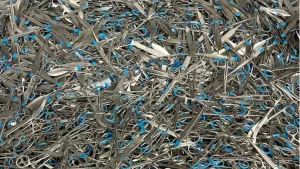Black belt in the OR?
Ritsaart van Montfrans · · 5 min readLean management has been used in many industries to improve performance. But how about the operating room? Given all its challenges, would that not be a great place to send in a Lean Six Sigma Black Belt?
Plenty of waste
Lean Six Sigma is used in many places to improve quality and efficiency of processes. By eliminating waste and reducing defects. Originally from the Toyota auto manufacturing, it is now used in all industries. Principles such as ‘first-time-right’ and a 'continuous improvement process' are powerful tools.
Lean Six Sigma
So, how about the OR? As per my earlier blogs, it’s a hectic place with little process support. The limited structure and standardisation of work processes in the OR make improvement processes challenging.
In terms of eliminating waste, Lean focuses on the following. Waste is defined as ‘any step or action that is not required to complete a process successfully'. Lean uses 8 categories:
- Defects - Efforts caused by rework, scrap, and incorrect information
- Overproduction - Production that is more than needed, or before it is needed
- Waiting - Wasted time waiting for the next step in the process
- Non-utilized talent - Underutilising people’s talent, skills and knowledge
- Transportation - Unnecessary movement of products and materials
- Inventory - Excess products and materials not being processed
- Motion - Unnecessary movement by people
- Extra processing - More work or higher quality than is required by the customer
For OR professionals, it is easy to recognise many of these. Here’s a few examples that occur on a daily basis:
- “The IV was placed incorrectly, I need 10 minutes to place it again on the other side of the patient “ (Defects)
- “I don’t have access to these documents, so I cannot prepare the details of today’s surgery” (Non-utilised talent)
- “I have explained already 20 times how I want to position the patient and how I want you to prepare this stapler’ (Defects)
- "Let’s open up all these clips already, just to be sure. Otherwise the surgeon may get angry with us …”, only to find out later that they were not needed after all (Overproduction)
- “Where is the pedal for this device? Is it in the other room again? Can somebody please get is ASAP?” (Defects)
- "Can somebody run to the Logistics room to get the implant? We need it now…” (Motion)
- “Today’s last patient is obese and we need extra long trocars. We mentioned this in the morning briefing …” (Defects)
Recognise a number of these? Many OR professionals do!
Improvement one-offs
Often, hospitals start projects to tackle these issues. Or, a very active team member stands up and takes the lead on a topic. Good improvements are achieved, and the team is energised.
But, the most difficult thing is then to maintain the impact for a longer period. Often enough, the improvements disappear again after a while. This may in part be due to the culture in many OR’s, since achieving this type of change requires a receptive environment for it (e.g., coaching and support from management, shared responsibilities, etc.).
One active scrub nurse team lead told me: "After I was assigned to a different role, the team went back to the old way of doing it”. Or, "we had to take away the improvement boards because it became a place with a lot of negative energy and management bashing". Another one I heard a few times: “we stopped doing it, it became a ‘ticking the box’ exercise…”. The new way needs to be embedded in the organisation in order to have a long term effect….
Continuous improvement loop
So, in our new Incision Teams product we have taken these challenges into account. And we have been creating our version of a Lean Six Sigma tool, with 2 key aspects:
- Structure. Capture the way of working in the OR in a structured way. If you want to improve a process, you need to have a solid base that describes how the work is done. We do this by digitising the OR protocol
- Improvements. Provide the teams with the right tools to become better every day. Every time ‘waste’ occurs it needs to be captured. And, a structured way needs to be used to follow up and solve it, so it does not happen again the next day. Getting a continuous improvement cycle in place requires that you organise these small steps, and that all OR team members can do this in a super-easy way. Making it ‘Kata’ (a Lean principle), if you repeat it for 30 days it becomes a habit....
Curious how this works?
We will be happy to explain you more and we will gladly bring you up to speed! We look forward to working with you to optimise your OR processes!







